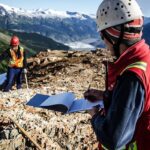
Isotropic vs Anisotropic: Examine Directional Traits Closely
Embarking on a captivating geological journey, we delve into the dynamic interplay between isotropic and anisotropic materials. This exploration aims to demystify the complexities surrounding these terms, offering a compelling narrative within the realm of rock physics.
Isotropic vs Anisotropic: Unraveling Geological Mysteries
In the realm of geophysics, the prevalent assumption is that the Earth is isotropic, showcasing uniformity in all directions. Conversely, anisotropy introduces directional variations, challenging the conventional understanding of uniform composition. Imagine microfractures, the alignment of clay flakes, or stress-induced orientation, adding layers of complexity to materials that, at first glance, appear homogeneous.
Thomsen’s Parameters: Decoding the Language of Anisotropy
A pivotal breakthrough in understanding anisotropy occurred with Leon Thomsen’s 1986 paper. Introducing parameters such as δ (delta), ε (epsilon), and γ (gamma), collectively known as Thomsen’s parameters, play a crucial role in describing anisotropic materials. They offer profound insights into the short offset effect, long offset effect, and shear wave effect, forming a linguistic bridge to decipher the intricacies of anisotropy.
Transverse Isotropy: Navigating the Directional Puzzle
Enter the intriguing world of transverse isotropy, a concept unraveling the orientation of anisotropic effects. Vertical transverse isotropy highlights differing horizontal and vertical velocities, influencing seismic moveout and introducing phenomena like the ‘hockey stick’ effect. These not only impact seismic gathers but also leave a distinctive mark on AVO (Amplitude Variation with Offset) analysis.
Tilted Transverse Isotropy (TTI) and Horizontal Transverse Isotropy (HTI)
When rocks exhibit a dip, we encounter tilted transverse isotropy (TTI), while vertically oriented anisotropies lead to horizontal transverse isotropy (HTI). These variations introduce azimuthal travel-time variations, potentially disrupting seismic imaging if not meticulously addressed during processing.
Orthorhombic Anisotropy: Charting Seismic Exploration Challenges
Venturing deeper, we confront orthorhombic anisotropy, a fusion of vertical and horizontal transverse isotropy. Recognizing and addressing these effects become pivotal in achieving optimal seismic images, preventing suboptimal outcomes and navigating the challenges posed by complex geological formations.
Dive into various river types with our guide!
Practical Insights
Amidst the complexities, practical insights serve as a compass for conceptualizing anisotropy. These guidelines become indispensable for researchers and practitioners navigating the intricate world of geophysics, ensuring a nuanced understanding and application of anisotropic principles.
Conclusion
As we conclude this exploration into the isotropic vs anisotropic realms, the profound significance of understanding these geological distinctions becomes evident in seismic analysis.
Thomsen’s parameters, transverse isotropy, and orthorhombic anisotropy collectively form the bedrock for accurate and insightful interpretations, underscoring the need for continued exploration and application in the dynamic field of rock physics.

















